|
|
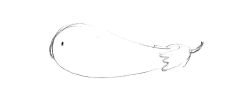
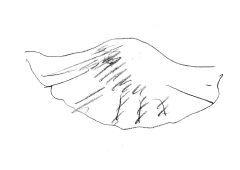
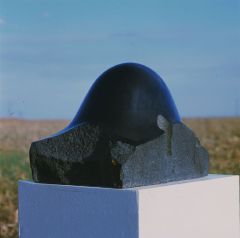
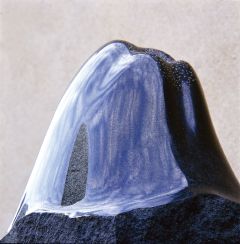
|
> With time your sculpture gets
increasingly simple and refined
_ To express an idea strongly, I do not need a complicated
shape. With a complicated shape the audience will endlessly
question the shape and find no answer. I want to eliminate
what is useless, simplify.
With simplicity you can say much more. “Less is more”.
> Are
you not afraid that your work will become impersonal ?
_ All the shapes I think I am creating have already been
explored by other artists, or exist in nature. I admire
minimalist yet sensible pieces such as Constantin Brancusi’s
«commencement du monde», Barbara Hepworth ‘s «discs in
echelon», some shapes are eternally new.
> Is simplification
for you just a means or a goal in itself ?
_ It’s a way for me to express my ideas, I do not want
to be a “minimalist” which I am not.
> Is it important
that people are able to recognize your signature, your style
?
_ I don’t ask myself that question when I create. I make
the sculpture as I feel it, I am not looking for a style,
but I have an identity. I live in the present moment.
> Are
you following the trends ?
_ I’m not running after fashion, I try to be myself. If
what I do is fashionable or not, is an entirely different
issue.
> 年を重ねるに連れて、あなたの彫刻は、ますます形が単純になり洗練されてきます。
_ 一つのアイデアを力強く表現するのに、複雑な形は別に必要ありません。 複雑な形では、見る人に疑問は与えるけれど回答は与えないでしょう。私は無意味な部分は切り離し、取り去ります。単純さは時にはより多くを語ります。英語のことわざでも「レス
イズ モア」と言います。
> いつの日か、個性のない仕事に終わる事を恐れませんか ?
_ 私がつくろうと思う全ての形は、他のアーティストによってすでに試されたか、自然の中に存在する形です。私はミニマリストの作品例えばコンスタンチン
ブランクーシーの「宇宙の誕生」、バルバラ ヘップワースの「等間隔の円盤」、など本当に素晴らしいと思います。何時になっても、新鮮で新しい形と言うのはあるものです。
> あなたにとって、単純化する事は一つの手段ですか、目的ですか
?
_ 私の考えを表す手段です。私は「ミニマルアーティスト」になりたいとは思いませんし、ミニマルアーティストでもありません。
> では、あなたのサイン、あなたのスタイルが分かる事は、大切ですか
?
_作品を制作しているとき、そういう問題は考えません。その時感じる作品を作るだけで、スタイルを探していませんし、スタイルを作ろうとも思いません。しかし私にはアイデンティティがあります。私は、今の瞬間を生きています。
> Avec le temps ta sculpture est
de plus en plus simple et raffinée
_ Pour exprimer une idée avec force, je n’ai pas besoin d’une forme compliquée.
Avec une forme compliquée le public interroge la forme et n’a pas de réponse.
Je veux retirer ce qui est inutile, dépouiller. Avec simplicité, je peux dire
plus de choses. Less is more.
> N’as tu pas peur d’aboutir un
jour à un travail impersonnel ?
_ Toutes les formes que je crois créer ont déjà été explorées
par d’autres artistes ou existent dans la nature. J’admire
des œuvres minimalistes et sensibles comme «commencement
du monde» de Constantin Brancusi, «discs in echelon» de
Barbara Hepworth. Il y a des formes qui sont éternellement
nouvelles.
> Pour toi la simplification est-elle
un moyen ou une fin ?
_ C’est un moyen pour exprimer mes idées, je ne veux pas
être un «artiste minimaliste», je ne le suis pas.
> Donc
est-il important qu’on puisse reconnaître ta signature, ton
style ?
_ Je ne me pose pas la question quand je créé, je fais
la sculpture que je sens, je ne cherche pas un style, je
ne veux pas faire un style, mais j’ai une identité. Je
vis l’instant présent.
> Est-ce que tu suis la mode ?
_ Je ne cherche pas la mode, je cherche à être moi-même.
Si ce que je fais est à la mode ou pas c’est un autre
problème.
|
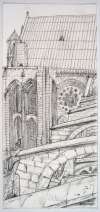 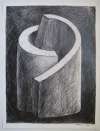 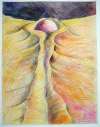 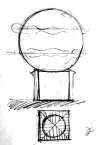 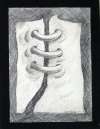 
  
|
> In your notebooks, I found some
photos of landscapes, close-ups of
materials.
_ I was doing research about landscapes, I was interested
by landscapes which were volcanic, moonlike, imaginary,
mineral, desert, forests, fields, the sea, disintegration...
Everything has an energy, I am very inspired by young mountain
ranges for example.
> Why do you live in Beauce now?
It is so flat.
_ Now I love this flat, calm landscape. I was born between
the mountain and the sea, now I live in a sea of green.
> あなたのスケッチブックの中に、いくつかの風景写真や素材のクロー
ズアップの写真を見つけました。
_ 私は風景について研究をしていました。火山の風景、月の空想表面、鉱物、砂漠、森林、畑、海、地質風化等に興味がありました。そのすべてがエネルギーを持っています。たとえば若い山のイメージ等からも多くの影響を受けます。
> なぜ、あなたは今とても平らな、ボース地方に住んでいるのですか
?
_ この大平原の静かで平らな景色が好きです。私は山と海の間で生まれ、今は植物の海に住んでいます。私は海の中にいる訳です。
> Dans tes carnets, j’ai retrouvé quelques photos de
paysages, des gros plans sur la matière.
_ Je faisais des recherches de paysages, j’étais intéressé
par des paysages volcaniques, lunaires, imaginaires, minéraux,
désertiques, les forêts, les champs, la mer, la désagrégation
...
Tout a une énergie, je suis très inspiré par les jeunes
montagnes par exemple.
> Pourquoi vivre maintenant en Beauce,
c’est si plat ?
_ Maintenant j’aime bien ce paysage calme, plat. Je suis
né entre et la montagne et la mer, aujourd’hui je vis dans
la mer de végétaux, je suis dans la mer.
|



|
> In your work
I feel that I can distinguish two types of sculptures:
eternal or ephemeral.
_ For me the mountain can be like a wave, I call this a landscape,
a movement. Earth is alive so it moves; it is constantly
developing. When I observe nature I enter an entire different
timescape; but, when I work, I do not think about it. When
I think about a mountain, I see it growing, I think about
lava, the moment lava freezes, the tectonic movements...
Moreover, the perception of objects is relative to the physical
presence of the person experiencing the object: I move in
space, I walk towards the mountain, the mountain gets closer,
it seems bigger.
> 私には、彫刻を2つのタイプに区別することができる気がします。永遠或いは儚さです。
_ 私にとって、山は波のようであり、私はこれを景色、動き、と呼びます。大地は生きているので、動き、発展します。私は自然を観察する時、もう一つスケールの違う時空の事を考えます。仕事をしている時は、それを考えませんが。私が山について考えるとき、その形成過程、溶岩が凝結する瞬間、構造地質などについて考えます。しかも、物の認識は相対的で、その物を経験する者の身体的な存在にも関係します。例えば、山の方向へ行く時、歩けば歩く程、山はより近くなります、そしてそれはより大きく感じられます。
> J’ai l’impression de pouvoir distinguer deux types
de sculptures : éternelle ou fugitive.
_ Pour moi la montagne, ce peut être comme une vague, j’appelle
cela un paysage, un mouvement. La terre est vivante, elle
bouge, elle se développe. Quand j’observe la nature, je
pense à une autre échelle de temps; quand je travaille,
je n’y pense pas. Quand je pense à une montagne, je pense
à sa formation, à la lave, au moment où elle se fige, à
la tectonique.
De plus, la perception des objets est relative à la présence
physique de celui qui expérimente l’objet : je me déplace
dans l’espace, je marche vers la montagne, la montagne
se rapproche, elle paraît plus grande.
|
| |
| |
| |
|
|
|
|
|
|
|
|
|
|